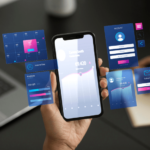No matter whether you are working as a designer yourself or with one, there are some key questions to ask regarding logo designs. In this article we cover everything from choosing the appropriate design to making sure the designer understands your vision for it.
One method for doing so is creating a mood board – this visual representation of your ideas can be invaluable when communicating with designers.
1. Have a clear vision of what you want
Ensure alignment with your designer by defining a clear vision. Research your brand, note specific colours, shapes, and symbols. Create a mood board with images and colour references to guide your logo design direction. Keep it simple for effective communication.
A mood board also gives your designer an idea of the visual style you like which may help them craft something to meet your specific requirements.
Ask your logo designer about their creative process; this will give you an idea of the length of time it will take and whether or not your expectations match theirs. If your deadline is tight, consider working with another designer who can meet those needs more quickly.
Remember your budget. Communicating this early with your designer will allow them to better understand what amount you can afford and any limits placed upon spending – this will prevent any misunderstandings later on about what items are included or excluded in your design package.
Ask your designer about their experience working within your industry. Someone familiar with it will have a greater grasp of your brand identity and can create designs that resonate with customers more successfully.
If your industry is new to them, they may require additional research and learning before producing the best possible results. While this might take more time upfront, in the end it could pay dividends with thoughtful designs from someone who understands both your company and customers.
2. Communicate with your designer
Once you’ve selected the designer you wish to work with, it is crucial that clear communication lines are set up immediately. Be sure to ask about their process and methods of keeping in contact throughout the project; furthermore be specific with regards to what you like and dislike so they know exactly what it is you require.
As soon as you start working with a designer, it’s advisable to share both your creative brief and mood board. Doing this allows them to gain a firm understanding of what your vision for the logo design entails – creating visuals can give a designer a quick way to grasp what you want accomplished.
As with any project, setting a timeline will help prevent confusion over expectations or miscommunication later on. Different designers may have different work habits – some may prefer frequent conversations while others don’t mind having weeks pass without touching a project at all.
One common pitfall occurs when clients do not share their business goals with designers, leading them to work exclusively on one aspect of the company and neglect other aspects. For instance, designers might start designing fonts for logos before considering how it will be used across other forms of branding materials.
At times, designers will add elements of the logo that weren’t requested explicitly by you. It is essential to ask why this element has been included so you can better understand their rationale – they may even convince you it fits well with your brand!
As part of your research process, it can also be helpful to show your designer some examples of logo designs you love – this will give them a better sense of what you want and may inspire them with some ideas of their own.
3. Show them some examples
Share examples of designs you like with your logo designer. It helps convey your vision and inspires new ideas. Look at industry peers for inspiration.
As part of your presentation to your designer, take time to consider how your logo should look on various forms of media. For instance, it might look good on billboards and posters while still remaining legible on business cards and smaller screens. Furthermore, consider what emotions your logo elicits; do you want it to convey serious professionalism, or could it convey energy and excitement instead?
Finally, ask your designer some questions about their own style and preferences – this will give them an idea of the kinds of ideas they’re considering for the project as well as help determine whether or not they will make an excellent team player.
If you’re working with a design studio, ask if they incorporate any humorous aspects into their work. While humour might not apply in every industry (especially weapons manufacturers or tobacco firms), adding some flair can set your company apart and add some personality.
Being specific with what you want from your logo designer can save both time and stress when working together on its design. By spending some time conducting research and communicating with your designer, you can ensure that the finished product will reflect what was initially envisioned.
4. Ask for feedback
Once you’ve conveyed what your design goals are and provided an understanding of your desired look, it’s time to show some examples. This helps your designer get an understanding of your vision and how it might translate to images; additionally it shows them what styles or elements appeal to you as this information aids their own design process.
When giving feedback, be specific and objective in order to avoid confusion and miscommunication. Furthermore, provide both positive and negative comments along with suggestions on how the designer could enhance the logo design – this helps your designer understand what’s working and what doesn’t while giving them clear goals for moving forward with future work.
Keep in mind that any feedback you receive will likely be subjective, since most people do not possess the lingo needed to express why they like or dislike something. If someone disagrees with your feedback, ask why they feel this way and continue questioning until you fully comprehend their reasoning.
If there are questions or issues with any aspect of the design or how it would function at scale, it’s best to address them early rather than discover later that your desired logo may not work in that format.
At this stage, it’s also wise to discuss payment and delivery expectations, which helps prevent confusion over how the logo will be delivered and provides your designer with an accurate understanding of how much the project will cost and when completion will occur.
Furthermore, make it clear who owns the final product; this will avoid potential conflicts later. This step is especially important if working with an agency or freelancer; having these things set in stone ahead of time will enable your designer to stay on schedule with delivery while making it simpler for you to approve designs.







